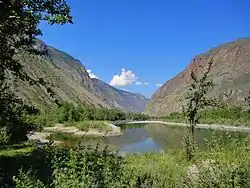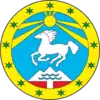Ulagansky District
Улаганский район | |
|---|---|
| Other transcription(s) | |
| • Altay | Улаган аймак |
 Chulyshman River area, a protected area of Russia in Ulagansky District | |
 Flag  Coat of arms | |
Location of Ulagansky District in the Altai Republic | |
| Coordinates: 51°57′N 85°57′E / 51.950°N 85.950°E | |
| Country | Russia |
| Federal subject | Altai Republic[1] |
| Established | October 19, 1923[2] |
| Administrative center | Ulagan[1] |
| Area | |
| • Total | 18,367 km2 (7,092 sq mi) |
| Population | |
| • Total | 11,388 |
| • Estimate (2018)[5] | 11,574 (+1.6%) |
| • Density | 0.62/km2 (1.6/sq mi) |
| • Urban | 0% |
| • Rural | 100% |
| Administrative structure | |
| • Administrative divisions | 7 Rural settlements |
| • Inhabited localities[1] | 13 Rural localities |
| Municipal structure | |
| • Municipally incorporated as | Ulagansky Municipal District[6] |
| • Municipal divisions[6] | 0 Urban settlements, 7 Rural settlements |
| Time zone | UTC+6 (MSK+3 |
| OKTMO ID | 84630000 |
| Website | http://улаган-адм.рф |
| 2010 Census | 11,388[4] |
|---|---|
| 2002 Census | 11,581[8] |
| 1989 Census | 11,176[9] |
| 1979 Census | 9,323[10] |
Ulagansky District (Russian: Улага́нский райо́н; Altay: Улаган аймак, Ulagan aymak) is an administrative[1] and municipal[6] district (raion), one of the ten in the Altai Republic, Russia. It is located in the east of the republic and borders Turochaksky District, Choysky District, Ongudaysky District, and Kosh-Agachsky District, as well as the republics of Tuva and Khakassia. The area of the district is 18,367 square kilometers (7,092 sq mi).[3] Its administrative center is the rural locality (a selo) of Ulagan.[1] As of the 2010 Census, the total population of the district was 11,388, with the population of Ulagan accounting for 28.3% of that number.[4] Altai make up 57.2% of the district's population, followed by Russians (20.2%), Telengits (16.3%), Kazakhs (4.5%) and Uzbeks (1.8%).[11]
Geography
The district is located in a mountainous area, away from major roads.[3] A large part of the district along the mountainous eastern border is in the Altai Nature Reserve.[3] The mountainous topography of the region, like the rest of the Altai Mountains, was created by tectonic movements of the Paleozoic age, more than 300-600 million years ago.
History
The district was established on October 19, 1923[2] within Oirot Autonomous Oblast.[12]
Administrative and municipal status
Within the framework of administrative divisions, Ulagansky District is one of the ten in the Altai Republic.[1] As a municipal division, the district is incorporated as Ulagansky Municipal District.[6] Both administrative[1] and municipal[6] districts are divided into the same seven rural settlements, comprising thirteen rural localities.[1][6] The selo of Ulagan serves as the administrative center of both the administrative[1] and municipal[6] district.
References
Notes
- 1 2 3 4 5 6 7 8 9 Law #101-RZ
- 1 2 Reference Book of the Administrative-Territorial Changes in Altai, p. 345
- 1 2 3 4 "District History" (in Russian). Ulagansky District. Retrieved June 29, 2017.
- 1 2 3 Russian Federal State Statistics Service (2011). Всероссийская перепись населения 2010 года. Том 1 [2010 All-Russian Population Census, vol. 1]. Всероссийская перепись населения 2010 года [2010 All-Russia Population Census] (in Russian). Federal State Statistics Service.
- ↑ "26. Численность постоянного населения Российской Федерации по муниципальным образованиям на 1 января 2018 года". Federal State Statistics Service. Retrieved January 23, 2019.
- 1 2 3 4 5 6 7 Law #10-RZ
- ↑ "Об исчислении времени". Официальный интернет-портал правовой информации (in Russian). June 3, 2011. Retrieved January 19, 2019.
- ↑ Russian Federal State Statistics Service (May 21, 2004). Численность населения России, субъектов Российской Федерации в составе федеральных округов, районов, городских поселений, сельских населённых пунктов – районных центров и сельских населённых пунктов с населением 3 тысячи и более человек [Population of Russia, Its Federal Districts, Federal Subjects, Districts, Urban Localities, Rural Localities—Administrative Centers, and Rural Localities with Population of Over 3,000] (XLS). Всероссийская перепись населения 2002 года [All-Russia Population Census of 2002] (in Russian).
- ↑ Всесоюзная перепись населения 1989 г. Численность наличного населения союзных и автономных республик, автономных областей и округов, краёв, областей, районов, городских поселений и сёл-райцентров [All Union Population Census of 1989: Present Population of Union and Autonomous Republics, Autonomous Oblasts and Okrugs, Krais, Oblasts, Districts, Urban Settlements, and Villages Serving as District Administrative Centers]. Всесоюзная перепись населения 1989 года [All-Union Population Census of 1989] (in Russian). Институт демографии Национального исследовательского университета: Высшая школа экономики [Institute of Demography at the National Research University: Higher School of Economics]. 1989 – via Demoscope Weekly.
- ↑ Всесоюзная перепись населения 1979 г. Национальный состав населения по регионам России [All Union Population Census of 1979. Ethnic composition of the population by regions of Russia] (XLS). Всесоюзная перепись населения 1979 года [All-Union Population Census of 1979] (in Russian). 1979 – via Demoscope Weekly (website of the Institute of Demographics of the State University—Higher School of Economics.
- ↑ Ахмедуев, Абас Шапиевич (December 1, 2020). "ПРОЕКТ СТРАТЕГИИ СОЦИАЛЬНО-ЭКОНОМИЧЕСКОГО РАЗВИТИЯ РЕСПУБЛИКИ ДАГЕСТАН ДО 2035 ГОДА: СОМНИТЕЛЬНЫЕ ЦЕЛИ И НЕУДАЧНЫЕ ПРОГНОЗЫ". Региональные проблемы преобразования экономики (4): 42–51. doi:10.26726/1812-7096-2020-4-42-51. ISSN 1812-7096.
- ↑ Reference Book of the Administrative-Territorial Changes in Altai, p. 345
Sources
- Государственное Собрание —Эл Курултай Республики Алтай. Закон №101-РЗ от 10 ноября 2008 г. «Об административно-территориальном устройстве Республики Алтай», в ред. Закона №51-РЗ от 6 октября 2015 г. «О внесении изменений в Закон Республики Алтай "Об административно-территориальном устройстве Республики Алтай"». Вступил в силу по истечении 10 дней после дня официального опубликования. Опубликован: Приложение к газете "Звезда Алтая", 14 ноября 2008 г. (State Assembly of the Altai Republic—El Kurultai. Law #101-RZ of November 10, 2008 On the Administrative and Territorial Structure of the Altai Republic, as amended by the Law #51-RZ of October 6, 2015 On Amending the Law of the Altai Republic "On the Administrative and Territorial Structure of the Altai Republic". Effective as of after 10 days after the official publication day.).
- Государственное Собрание —Эл Курултай Республики Алтай. Закон №10-РЗ от 13 января 2005 г. «Об образовании муниципальных образований, наделении соответствующим статусом и установлении их границ», в ред. Закона №12-РЗ от 31 марта 2015 г. «О преобразовании муниципальных образований на территории Майминского района Республики Алтай и о внесении изменений в Закон Республики Алтай "Об образовании муниципальных образований, наделении соответствующим статусом и установлении их границ"». Опубликован: "Звезда Алтая", №7–8, №23–24, 18 января 2005 г., 5 февраля 2005 г. (State Assembly of the Altai Republic—El Kurultai. Law #10-RZ of January 13, 2005 On Establishing the Municipal Formations, on Granting Them an Appropriate Status, and on Establishing Their Borders, as amended by the Law #12-RZ of March 31, 2015 On the Transformation of the Municipal Formations on the Territory of Mayminsky District of the Altai Republic and on Amending the Law of the Altai Republic "On Establishing the Municipal Formations, on Granting Them an Appropriate Status, and on Establishing Their Borders". ).
- Исполнительный комитет Алтайского краевого Совета народных депутатов. Архивный отдел. Государственный архив Алтайского края. "Справочник административно-территориальных изменений на Алтае, 1917–1980" (Reference Book of the Administrative-Territorial Changes in Altai, 1917–1980). Барнаул, Алтайское книжное издательство, 1987.